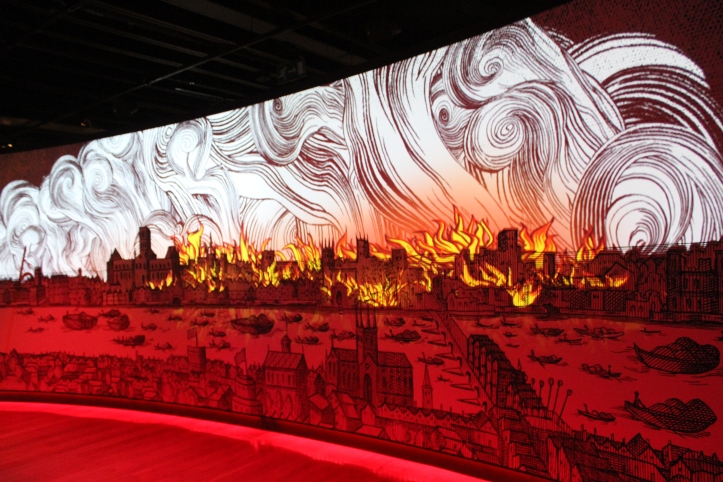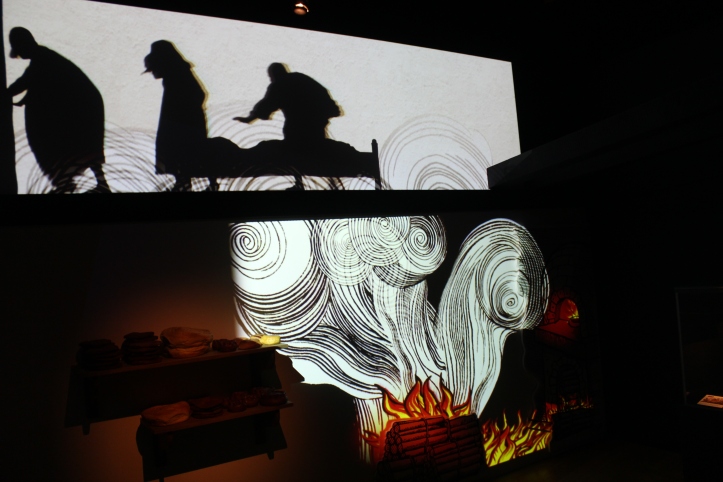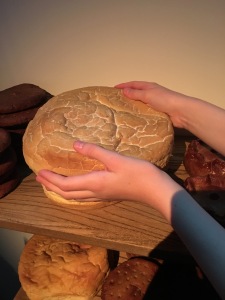 We all know about the Great Fire of London don’t we? It is embedded into our joint historical narrative. Every school child commits dates – 1666, places – Pudding Lane, and causes – the bakers oven, to memory. When my kids hit Year 2 at school and they start to learn about the Great Fire we make the pilgrimage to the Monument, I sit them on the wall by the Pudding Lane street sign and take a picture. Finally we have a quick trip to the Museum of London to watch a flickering diorama before returning, wearily, home.
We all know about the Great Fire of London don’t we? It is embedded into our joint historical narrative. Every school child commits dates – 1666, places – Pudding Lane, and causes – the bakers oven, to memory. When my kids hit Year 2 at school and they start to learn about the Great Fire we make the pilgrimage to the Monument, I sit them on the wall by the Pudding Lane street sign and take a picture. Finally we have a quick trip to the Museum of London to watch a flickering diorama before returning, wearily, home.
Putting on a Great Fire exhibition in this context, particularly in the fire’s 350th anniversary year seems fairly straightforward doesn’t it? That is the nub of the problem, if we all know the story so well how do you tell it afresh? ‘Fire Fire’ at the Museum of London is a family friendly exhibition. That just makes the whole job three times as hard. Selecting objects, interaction and interpretation to entertain kids and adults is no easy thing, particularly if you want the impact to be seamless.
The Museum of London make it work in my eyes and here is why –

1 – Simple narrative thread (on bread!) – don’t mess with a timeline, it makes events easy to understand. Before the fire, the fire and after the fire. Simple

2 – Fantastic theatrical setting – you begin in the dark overcrowded narrow streets of London. The stand out objects here are the wooden brackets used to hold the upper floors or jetties of 17th century buildings. Never displayed before in this way they are a spooky evocation of old London. I imagine as I walk by that they will whisper their secrets in my ear. From dark streets to red hot flickering flames and finally to the cool aftermath and greys of ash and the soothing release of a new day.

The theatre, the digital recreations, the sounds and smells make it exciting for children, there is magic floating around like burnt out cinders in the air. Whilst a sensory experience is exciting, I hope the museum will consider offering some ‘quiet days’ with sounds and smells turned off to help those families that find sensory issues a barrier.

3 – Fun – yes, there are things to do for kids (big and little, see point 4) but for goodness sake there are giant loaves hanging from the ceiling!

4 – Stuff for kids – hands on real Great Fire objects, dress up, digital games, imaginative play and creative building. All of which adults can do too in case you were wondering.

But what about actual exhibition content? It is here that I find a dichotomy to the exhibition. There is the paper based evidence, the written word, letters, books, pamphlets and of course diaries. Whilst they are fantastic, they can be hard to take on board, they are tricky to read, the handwriting is difficult and the low lighting levels make it a challenge. Whilst some letters have audio excerpts, I would love to hear the whole thing. The most successful letters I have seen displayed were in the Sexology exhibition at the Wellcome Collection, on a comfy bench I sat with a friend, headphones on and listened to a number of full length transcriptions. Admittedly the topic was sex but the full audio added immeasurably to the whole experience. I am won over though by another exhibit, I do not need to read the pages to love the bible burnt at the edges, a precious book saved and passed down through the years. How many households would save a ‘good’ book now?

So on one hand we have all these fun kids activities and digital excitement and on the other dry text, but what really brings the whole thing together for me is the archaeology. The stunning, mesmerising objects – there is a leather bucket, at first glance so unremarkable, excavated from a burnt house on Lower Thames Street, the date on it is 166_ with the last digit missing. Was it used in an attempt to put out a burning building in the Great Fire? There are quirky flat street signs used to conform with new building regulations that after the fire prevented signs hanging out in the street, a cheeky monkey, a grand spread eagle, a black swan I seem to remember making an appearance in the Cheapside Hoard exhibition.

There is fragile glass, just a small portion of the 600 objects excavated from a building on Gracechurch Street. So delicate, how have they survived the ravages of fire and time? But my heart is lost to padlocks excavated from a house in Botolph Lane, the everyday and useful made eternally interesting by their association with the Great Fire. I spent time speaking to the archaeological conservator Rebecca Lang who highlighted their fragility. Concern over the continual replacement of silica gel in the casing to keep environmental conditions right was paramount while the objects were on display as well as in storage. We talked about the question of how it will be possible to keep these messages from history alive before they crumble away in front of our eyes. The x-rays of these padlocks, displayed at a touch of a button, reveal their inner beauty, their true selves. The damage and destruction of fire and corrosion is stripped away for fleeting seconds. Such simple objects, beautifully lit, speak to me more powerfully than any written word.



I have spoken of what we all know of the fire, so how does this exhibition tell us a new story. I sat down and asked my two kids, 12 and 8, what they knew of the fire, I limited them to five facts each. Some cheese and Samuel Pepys featured heavily in the list. But there is one thread I want to add to their understanding and ‘Fire Fire’ has shone a light on aspects of events in 1666 that I have not really thought about before.

The aftermath, which led to 100,000 people being displaced and homeless living in the fields that surrounded the City. There is a quiet corner easily overlooked where a tent is set up and voices tell the story of loss, of fear, of worry and concerns for the future. There is also a case you can pack yourself, what would you take: food? A photograph? This is the story we need to tell of the fire. In a world framed with violence and upset, with intolerance and hate, we need to teach what it means to have your world turned upside down. How it is part of our history, not just other countries, and how it can happen to anyone at anytime. Not to spread fear but resilience, to build those ideas that there will always be someone there to hold out a hand, to help and to console.

That is the Great Fire’s narrative that we need to teach today. The final section at the end of the exhibition is where you can build your own London. Kids will build themselves new homes, impressive streets and madcap towers. I doubt very much they will be building affordable housing and shelters for those in need. But those kids will be the planners and builders of the future and the things they learn, see and feel will be very much a part of the future they build.

The Great Fire is part of our history, in truth it is just one of many fires, in truth it is just one disaster of many catastrophes that London has faced. But the time has come for the legacy to be more than one man’s diary and some cheese hidden in the garden. In the fire’s 350th year the Museum of London is leading the way to a new interpretation, and whether you studied the Great Fire in school or have yet to fully understand it’s implications the museum is offering you a perfect place to begin anew.
xxxxxxxxxxxxxxxxxxxxxxxxxxx
Fire Fire opens at the Museum of London on Saturday 23 July – 17 April 2017 to find out more and book tickets please see the website – https://www.museumoflondon.org.uk/museum-london/whats-on/exhibitions/fire-fire











Very thoughtful analysis of the lessons that can and should be taken away from this exhibit. How is it adapted to children with autism?